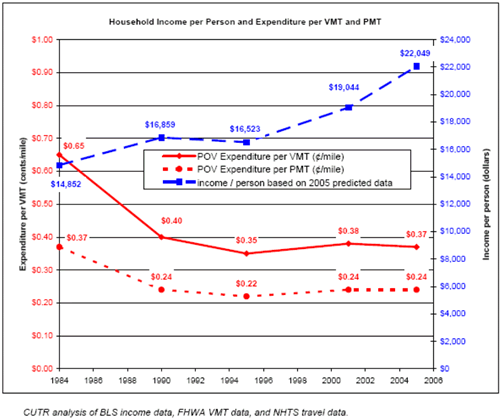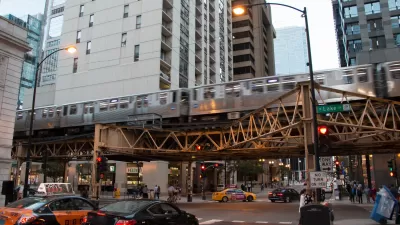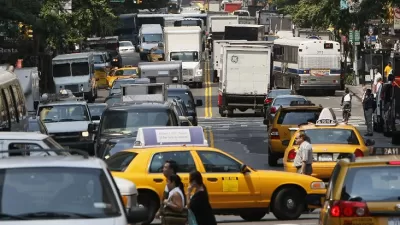In spring 2007, the Texas Transportation Institute and its partners will release the newest version of the "Mobility Report." This eagerly-awaited document will chronicle the worsening congestion in urban and suburban America. The report typically spawns a frenzy of media stories as folks eagerly peruse the ranking lists finding out just how their area did. While methodology tweaks and data issues might add a few wrinkles, no one will be surprised to see congestion worse than the prior report two years ago. Surprise, surprise!
In spring 2007, the Texas Transportation Institute and its partners will release the newest version of the "Mobility Report." This eagerly-awaited document will chronicle the worsening congestion in urban and suburban America. The report typically spawns a frenzy of media stories as folks eagerly peruse the ranking lists finding out just how their area did. While methodology tweaks and data issues might add a few wrinkles, no one will be surprised to see congestion worse than the prior report two years ago. Surprise, surprise! We failed to invest sufficiently in transportation infrastructure and services, and we failed to price transportation infrastructure and services correctly--but we continue to wail about the growing crisis. Some folks go on to explore the causes of worsening congestion, attributing it to failed urban development policies, misdirected transportation spending priorities, evidence that we can't build our way out of congestion, lack of transportation-land use coordination, and a number of other factors. In fact, a huge share of the problem is that we under-price travel and under-invest in transportation infrastructure and service. As shown in the figure below, income per capita (even adjusted for inflation) has been increasing, and travel costs have remained very low when measured by household spending per vehicle mile of travel.

Not surprisingly, there is no cost deterrent to encourage traveling less. While a typical household spent over $400 more on fuel in 2005 compared to 2004, and fuel costs may have again increased a few hundred dollars last year (BLS data not yet available), the additional average annual cost of fuel is far less than the cost of those fancy big wheels and low-profile tires, the add-on sunroof, or the stereo upgrades. A very competitive auto market, low interest rates, cars that are well into their teenage years before being junked, and safety improvements that keep insurance costs down have helped to keep total spending for auto transportation relatively stable. While politicians have been scared to death to even talk about gas tax increases, the contractors building roads or transit systems are not at all bashful about passing on their much higher costs for construction. Let's not even think about the cost increases for right-of-way. Construction cost indices alone show dramatic declines in buying power for transportation dollars. When this is coupled with right-of-way costs, maintenance of transportation costs, scope creep to satisfy every imaginable constituency, and assorted other cost elements, it is not uncommon to see project costs increasing 50 to 100% over the last three or four years.
Next time you throw a coin in the wishing well, wish for wisdom and backbone for our transportation decision-makers. Then go retrieve the coin--you might need it to pay tolls.

Planetizen Federal Action Tracker
A weekly monitor of how Trump’s orders and actions are impacting planners and planning in America.

Restaurant Patios Were a Pandemic Win — Why Were They so Hard to Keep?
Social distancing requirements and changes in travel patterns prompted cities to pilot new uses for street and sidewalk space. Then it got complicated.

Map: Where Senate Republicans Want to Sell Your Public Lands
For public land advocates, the Senate Republicans’ proposal to sell millions of acres of public land in the West is “the biggest fight of their careers.”

Maui's Vacation Rental Debate Turns Ugly
Verbal attacks, misinformation campaigns and fistfights plague a high-stakes debate to convert thousands of vacation rentals into long-term housing.

San Francisco Suspends Traffic Calming Amidst Record Deaths
Citing “a challenging fiscal landscape,” the city will cease the program on the heels of 42 traffic deaths, including 24 pedestrians.

California Homeless Arrests, Citations Spike After Ruling
An investigation reveals that anti-homeless actions increased up to 500% after Grants Pass v. Johnson — even in cities claiming no policy change.
Urban Design for Planners 1: Software Tools
This six-course series explores essential urban design concepts using open source software and equips planners with the tools they need to participate fully in the urban design process.
Planning for Universal Design
Learn the tools for implementing Universal Design in planning regulations.
Heyer Gruel & Associates PA
JM Goldson LLC
Custer County Colorado
City of Camden Redevelopment Agency
City of Astoria
Transportation Research & Education Center (TREC) at Portland State University
Camden Redevelopment Agency
City of Claremont
Municipality of Princeton (NJ)






























